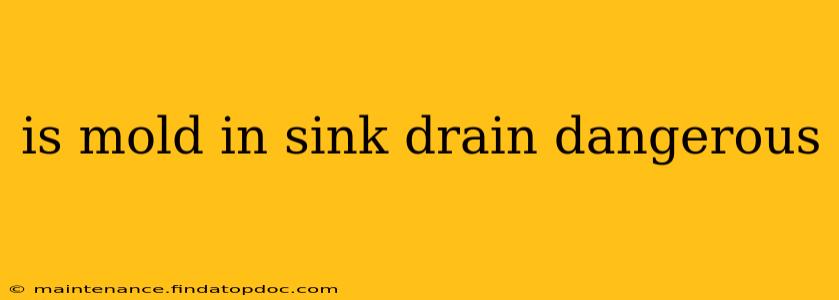Mold in your sink drain might seem like a minor inconvenience, but it's crucial to understand the potential health risks and how to address this issue effectively. Ignoring it can lead to more significant problems, impacting both your health and the longevity of your plumbing system. This guide will delve into the dangers, prevention, and remediation of mold in sink drains.
What are the Dangers of Mold in a Sink Drain?
Mold, in general, produces mycotoxins—toxic substances that can cause various health problems, especially for individuals with pre-existing respiratory conditions or allergies. The type and quantity of mold present in your drain will dictate the severity of the potential health risks. However, even small amounts can be problematic.
Common health concerns associated with mold exposure include:
- Respiratory issues: Coughing, wheezing, shortness of breath, and allergic reactions such as sneezing and runny nose. Individuals with asthma may experience exacerbated symptoms.
- Skin irritation: Contact with mold can cause rashes, itching, and other skin reactions.
- Eye irritation: Similar to skin irritation, mold spores can irritate the eyes, causing redness, itching, and burning.
- More serious issues (rare but possible): In rare cases, prolonged exposure to high concentrations of certain molds can lead to more serious health problems, particularly in individuals with compromised immune systems.
What Types of Mold are Commonly Found in Sink Drains?
Several mold species thrive in the damp, dark environment of a sink drain. Identifying the precise type often requires laboratory analysis, but some common culprits include Cladosporium, Penicillium, and Aspergillus. These molds can reproduce quickly, forming colonies and spreading beyond the drain if left untreated.
How Can I Tell if I Have Mold in My Sink Drain?
Detecting mold in a sink drain isn't always straightforward. It's often hidden from view. However, you can look for these telltale signs:
- Musty odor: A persistent, unpleasant, earthy smell emanating from your sink drain is a strong indicator of mold growth.
- Visible mold: If you can see a slimy, fuzzy growth inside the drain, it's a clear sign of a mold problem. This is most often visible in slow-draining or clogged drains.
- Slow drainage: Mold growth can contribute to slow or clogged drains as it builds up and restricts water flow.
How Do I Prevent Mold Growth in My Sink Drains?
Prevention is key when dealing with mold. Regular cleaning and maintenance are crucial to minimizing the risk of mold growth in your sink drains.
- Regular cleaning: Pour boiling water down the drain once a week to help eliminate bacteria and mold spores.
- Baking soda and vinegar: This natural cleaning duo is highly effective at removing grease and grime, preventing mold buildup. Pour baking soda followed by vinegar down the drain, then let it fizz for about 30 minutes before flushing with hot water.
- Keep drains clean: Remove hair and debris regularly to prevent clogs that can create a humid environment conducive to mold growth.
- Proper ventilation: Ensure adequate ventilation in your bathroom or kitchen to minimize moisture buildup. Use exhaust fans during and after showering or washing dishes.
Is it Dangerous to Clean Mold in My Sink Drain Myself?
While cleaning mold in your sink drain yourself might seem simple, it's important to take precautions. Direct contact with mold can trigger allergic reactions or respiratory problems. If the mold infestation is extensive or you're uncomfortable handling it, it's best to contact a professional mold remediation service.
What Should I Do if I Have a Severe Mold Problem in My Sink Drain?
For extensive mold infestations, professional help is recommended. A mold remediation specialist can identify the type of mold, assess the extent of the problem, and safely remove it while following safety protocols. They can also address the underlying causes of the mold growth, preventing future problems.
Can I use bleach to kill mold in my sink drain?
Bleach can kill mold, but it's not always the best solution for sink drains. Bleach can damage some plumbing materials and its effectiveness is often limited if the mold has deeply penetrated. For mild cases, boiling water and baking soda/vinegar are often better options. For serious infestations, call a professional.
This comprehensive guide provides insights into the dangers of mold in sink drains, preventative measures, and the best course of action depending on the severity of the problem. Remember, prevention is the best approach; regular cleaning and maintenance are your best allies against mold growth. If you suspect a significant mold issue, it’s always wise to seek professional help to ensure your safety and the long-term health of your plumbing system.
